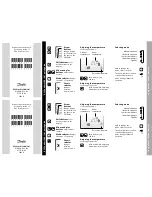
Some types of batteries benefit from regular equalise charges which can stir the electrolyte, balance
the battery voltage and finish the electrochemical reaction. Equalise charging raises the battery
voltage to a higher level than the standard supply voltage and gases the battery electrolyte. If the
controller then automatically steers the battery into equalise charging, the charging duration is 120
minutes (default). In order to avoid too much generated gas or battery overheat, equalise charging
and boost charging won’t repeat in one complete charging cycle.
Note:
Whe
n due to the installation environment or working loads, the system can’t continuously
stabilise the battery voltage to a constant level, the controller will initiate a timing process,
and 3 hours after the battery voltage reaches the set value, the system will automatically
switch to equalise charging.
If no calibration has been done to the controller clock, the controller will perform equalise
charging regularly according to its internal clock.
Float Charging:
when finishing sustaining charging stage, the controller will switch to float charging
in which the controller lowers the battery voltage by diminishing the charging current and keeps the
battery voltage at the set value of float charging voltage. In the float charging process, very light
charging is carried out for the battery to be maintained at full state. At this stage, the loads can
access almost all the solar power. If the loads consume more power than the solar panel could
provide, the controller will not be able to keep the battery voltage at the float charging stage. When
the battery voltage drops to the set value for returning to boost charging, the system will exit float
charging and re-enter into fast charging.
Be very careful when installing the battery. For wetcell batteries, wear a pair of gloves
during installation, and in case of contact with battery acid, flush with water immediately.
In order to prevent the battery from being short-circuited, no metal objects should be
placed near the battery.
Acid gas may be generated during battery charging, ensure the ambient environment is well
ventilated.
Keep the battery away from fire sparks as the battery may produce flammable gas.
When installing the battery outdoors, take sufficient measures to keep the battery away
from direct sunlight and rain water intrusion.
Loose connections or corroded wires may cause excessive heat generation which may
further melt the wire’s insulation layer and burn surrounding materials, and even cause a
fire, therefore make sure all connections are tightened securely. Wires has better be fixed
properly with ties, and when needs arise to move things avoid wire swaying so as to keep
connections from loosening.
When connecting the system, the output terminal’s voltage may
exceed the top limit for
human safety. If operation needs to be done, be sure to use insulation tools and keep hands
dry.



































